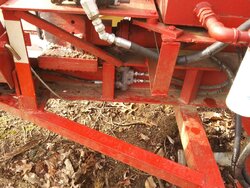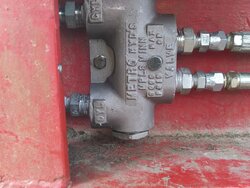I caught a break with the cold temps yesterday, the ground froze up, mostly. Normally, I've been splitting on location to contain the debris. But, I was able to scamper the loader into the woods and pull out the remaining large rounds I had on the ground, before the afternoon thaw, and bring them over to my old staging area to split them all up.
-
Active since 1995, Hearth.com is THE place on the internet for free information and advice about wood stoves, pellet stoves and other energy saving equipment.
We strive to provide opinions, articles, discussions and history related to Hearth Products and in a more general sense, energy issues.
We promote the EFFICIENT, RESPONSIBLE, CLEAN and SAFE use of all fuels, whether renewable or fossil.
You are using an out of date browser. It may not display this or other websites correctly.
You should upgrade or use an alternative browser.
You should upgrade or use an alternative browser.
Todd67
Minister of Fire
I used my 8 pound maul to split some large splits that would be difficult for my wife to load into the stove. It's way too cold to use my gas splitter, -4 now and maybe a high of 5 today.
XmasTreefarmer
Feeling the Heat
i've had my MTD 25T splitter since about 2004 - it's been a great machine. It's still going strong splitting about 4 cords a year. I happened to catch a YouTube video of a guy who was adding a Splitter Table to his Black Diamond Splitter. As soon as I saw that I was thinking, I've got to get one of those!
No more taking a big half split off and setting by my feet while I split the other half, no more pieces falling off on the other side of the splitter that I have to walk around and pick up. The older I get the more I am into conservation of energy - mine!
I looked at the metal splitter tables and there were none that would fit my splitter. Then I looked into modifying one to fit my splitter - that was going to be a lot of drilling and bending of steel - not my strong suit. Then I had a brainstorm - make one out of a scrap of 3/4" Treated Plywood that I had in the basement! I loved the price - free! I bolted it right on to the existing log cradle on the side opposite the operator. I tried it out and it worked great, but it needed a "stop" across the end to prevent pieces from sliding off, so I added that. Since I had it in the basement I decided to paint it to match the splitter. I just happened to have some Black and some Red paint on hand. Click to enlarge the images.
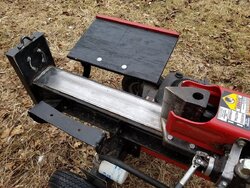
And here's the table in action!
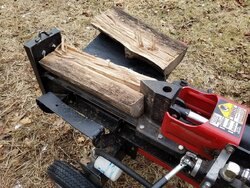
It's a super time saver.
No more taking a big half split off and setting by my feet while I split the other half, no more pieces falling off on the other side of the splitter that I have to walk around and pick up. The older I get the more I am into conservation of energy - mine!

I looked at the metal splitter tables and there were none that would fit my splitter. Then I looked into modifying one to fit my splitter - that was going to be a lot of drilling and bending of steel - not my strong suit. Then I had a brainstorm - make one out of a scrap of 3/4" Treated Plywood that I had in the basement! I loved the price - free! I bolted it right on to the existing log cradle on the side opposite the operator. I tried it out and it worked great, but it needed a "stop" across the end to prevent pieces from sliding off, so I added that. Since I had it in the basement I decided to paint it to match the splitter. I just happened to have some Black and some Red paint on hand. Click to enlarge the images.

And here's the table in action!

It's a super time saver.
I was reading about some small engine horror stories where the spark plug is cross threaded from the factory, so I decided to check mine. All is fine and I added a dab of copper never seize.
XmasTreefarmer
Feeling the Heat
I was reading about some small engine horror stories where the spark plug is cross threaded from the factory, so I decided to check mine. All is fine and I added a dab of copper never seize.
Well that sounds like a relief. Always good when you have done something to the machine or the engine so that you know it's right. When I'm replacing a plug I always use a high temp never seize - it's just good insurance - and then I only start them with my fingers - either on the plug or on a socket with the plug in it. No way to cross thread it if you do it like and then switch to a wrench once you know it's going in right. I'm also a fan of torquing to the mfgs, spec. I feel like I can probably do it by feel, but feel better when I use the torque wrench.
Ashful
Minister of Fire
I suspect the torque spec is for dry thread. De-rate for lubed thread, if you’re putting anti-seize on the threads.
Dieselhead
Minister of Fire
Towed it out from winterization today to take care of some problem pines I’ve been dealing with. I’ve had good luck with the Ariens 27 ton. Have at least 50 cord through it.
XmasTreefarmer
Feeling the Heat
I suspect the torque spec is for dry thread. De-rate for lubed thread, if you’re putting anti-seize on the threads.
Ashful - Nice catch! Thank you. Thought I knew what I was doing, but I didn't. Back in the day, it seemed that mfg's spec manuals specified some lubricant before torquing. Then they listed the torque values for each fastener. I just extended that to spark plugs.
I just checked and found information from NGK where they specifically state NOT to use any sort of anti-seize before torquing a spark plug. They warn that doing so may result in over-tightening and damage to the plug and/or cylinder head! They also said that all NGK plugs are treated with corrosion resistant plating, so do not require any corrosion protection.
I've been using anti-seize on spark plugs for probably 40 years and have not had a problem, but I'll never use it again. I always torque to the low value in the range and perhaps that's what's been saving me. There's just something about a steel thread spark plug screwing into an aluminum head that has always made me cautious.

Ashful
Minister of Fire
Ashful - Nice catch! Thank you. Thought I knew what I was doing, but I didn't. Back in the day, it seemed that mfg's spec manuals specified some lubricant before torquing. Then they listed the torque values for each fastener. I just extended that to spark plugs.
I just checked and found information from NGK where they specifically state NOT to use any sort of anti-seize before torquing a spark plug. They warn that doing so may result in over-tightening and damage to the plug and/or cylinder head! They also said that all NGK plugs are treated with corrosion resistant plating, so do not require any corrosion protection.
I've been using anti-seize on spark plugs for probably 40 years and have not had a problem, but I'll never use it again. I always torque to the low value in the range and perhaps that's what's been saving me. There's just something about a steel thread spark plug screwing into an aluminum head that has always made me cautious.
I understand the desire to lube, I usually like to apply anti-seize on all of my fasteners, as well. I suppose you could look at the typical ratio of lubed to dry torque values for a fastener of similar diameter and pitch, and then divide the dry torque value for the spark plug by that ratio, but I’ve always just relied on having clean new threads on my plugs. I also tend to replace plugs every year or two, even though I’m usually well short of the prescribed lifetime or cleaning interval.
XmasTreefarmer
Feeling the Heat
I understand the desire to lube, I usually like to apply anti-seize on all of my fasteners, as well. I suppose you could look at the typical ratio of lubed to dry torque values for a fastener of similar diameter and pitch, and then divide the dry torque value for the spark plug by that ratio, but I’ve always just relied on having clean new threads on my plugs. I also tend to replace plugs every year or two, even though I’m usually well short of the prescribed lifetime or cleaning interval.
I too am a fan of replacing plugs every few years whether it's called for or not. It's such cheap insurance that that part of the ignition system is working (and you get a chance to inspect the plug that you remove to see if the engine might be running a little rich, a little lean, or if there are oil issues developing.
A couple of times in my many years of using internal combustion engines I've had an engine not running right that was giving me fits wondering if I had old gas in the tank, clogged air filter, or what? Turned out that a plug that looked good, wasn't. Especially if you are doing all of your own work, you can so easily afford to put a plug in which only costs a few bucks.
I installed an adjustable hold valve within my lift circuit today. I got it because the larger rounds were torquing and bouncing the splitter as I lifted them. I initially unsuccessfully tried a line restrictor to slow the lift down. A buddy of mine has 40" rounds and I needed to have greater control of the lift speed. With this installed, it gives me really precise and minute control of the lift in the upward and downward stroke. I am not worried so much about lowering the lift with a load, but with this hold installed, lowering the lift with a load is also more controlled. Works better than the load check within a spool since it is adjustable.
Attachments
salecker
Minister of Fire
Make your own out of conveyor belting...The spider appears to be all chewed up, think you were onto something. thank you
Will get a new part and I will report back!
Thats whats in mine for the last 5 years.
No parts stores around hear,4 hour drive round trip to the nearest civilization.
Sean McGillicuddy
Minister of Fire
firefighterjake
Minister of Fire
I moved mine over a dite on Sunday so I could get my snowmobile out of the shed.
fbelec
Minister of Fire
maple1
Minister of Fire
Mine didn't get started all year, this year. Been 14 months since I used it.
Woodsplitter67
Minister of Fire
What have I done to or with my splitter... All I can say is that what I did... is illegal in most states including Arkansas...
johneh
Minister of Fire
I took a look at mine to see that there were
no unwanted critters making it there home
under the cover
no unwanted critters making it there home
under the cover
I have 2 splitters - a little one, 8 ton, and a 22 ton DHT. I haven't used the 22-ton for a few years (oops). I tried to get it started but it isn't starting. So, I moved over to the little splitter. It needed a few repairs, 1) reattached the gas tank with rubber washers, 2) new air hose w/clamp, 3) one new wheel, and 4) new hydraulic oil. The little beast fired right up. It is kind of loud.
It has been a while for me since I've used a splitter. It is a slow going splitter, but I've started working my way through about 12 cords of rounds - I've split 1/2 cord so far. I've already got the splitter stuck twice in knots, and had to use a sledge to get the wood free (oh yeah, you can't start in a knot with a 8-ton splitter).
I've been splitting ash (white), red elm (purplish), ponderosa pine (pinkish orange), and russian olive (chocolate). I like splitting the red elm the best. The ash is 'buggy' on the inside so some of it isn't straight grained. And some is big. The little splitter will split it but it is a pain to get it in place on the splitter. And ponderosa rounds had a lot of branches so knotty. I'll try to split a cord a day now that I'm up and splitting again.
It has been a while for me since I've used a splitter. It is a slow going splitter, but I've started working my way through about 12 cords of rounds - I've split 1/2 cord so far. I've already got the splitter stuck twice in knots, and had to use a sledge to get the wood free (oh yeah, you can't start in a knot with a 8-ton splitter).
I've been splitting ash (white), red elm (purplish), ponderosa pine (pinkish orange), and russian olive (chocolate). I like splitting the red elm the best. The ash is 'buggy' on the inside so some of it isn't straight grained. And some is big. The little splitter will split it but it is a pain to get it in place on the splitter. And ponderosa rounds had a lot of branches so knotty. I'll try to split a cord a day now that I'm up and splitting again.
Last edited:
Sean McGillicuddy
Minister of Fire
Worked the bastard this weekend...funny as I was running it when it kicked into second. The engine throttle would kicked down ... Hmm went and changed the filter ..all is right again ....
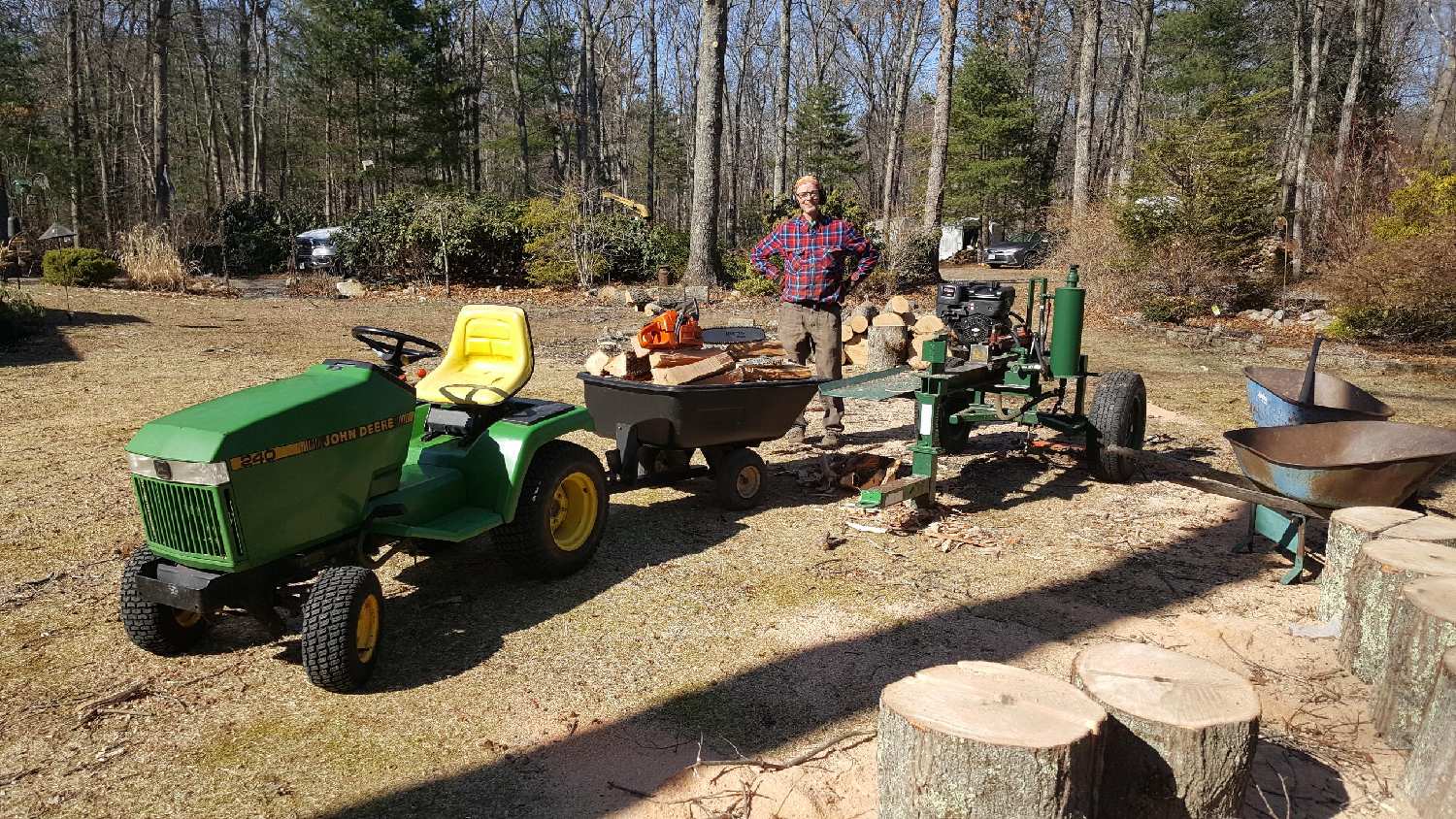

I got a couple extra in my onboard tool box just for that reason.Make your own out of conveyor belting...
Thats whats in mine for the last 5 years.
No parts stores around hear,4 hour drive round trip to the nearest civilization.
Similar threads
- Replies
- 7
- Views
- 1K
- Replies
- 0
- Views
- 953
- Replies
- 5
- Views
- 201


